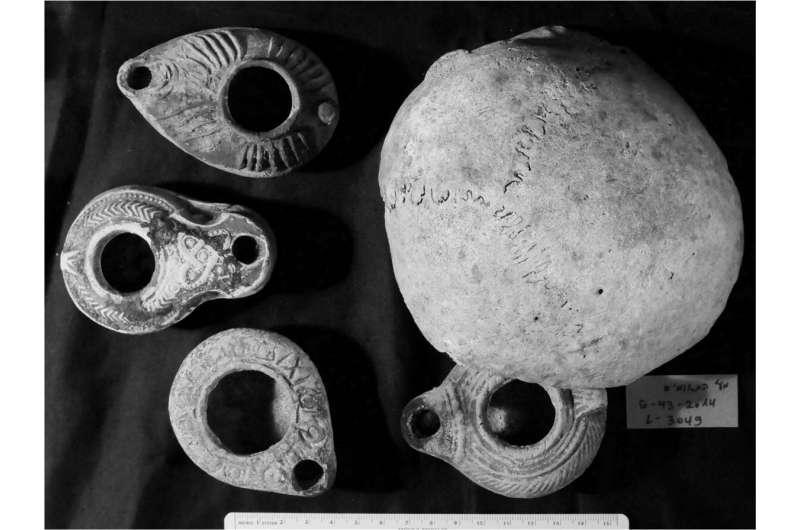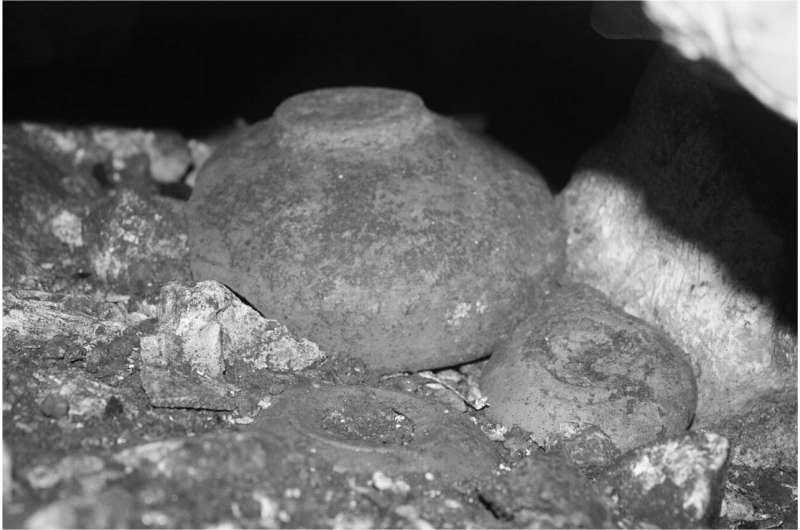Bob Yirka , Phys.org
Source - https://phys.org/news/2023-07-placement-ancient-hidden-lamps-skulls.html
 Finds from L. 3049: oil lamps found underneath the upper part of a human skull (frontal and parietal bones) (photo: B. Zissu under the Te'omim Cave Archaeological Project). Credit: Harvard Theological Review (2023). DOI: 10.1017/S0017816023000214
Finds from L. 3049: oil lamps found underneath the upper part of a human skull (frontal and parietal bones) (photo: B. Zissu under the Te'omim Cave Archaeological Project). Credit: Harvard Theological Review (2023). DOI: 10.1017/S0017816023000214
A pair of archaeologists, one with the Israel Antiquities Authority, the other from Bar-Ilan University, has found evidence of Roman-era necromancy practices in a cave in Israel. In their study, reported in the journal Harvard Theological Review, Eitan Klein and Boaz Zissu analyzed artifacts excavated from the Te'omim Cave over the past 14 years.
The Te'omim Cave has played a role in the history of what is now the Jerusalem hills region west of the famous city. During the Bar-Kokhba Revolt, for example, it served as a hideout for Jewish rebels. In this new effort, the researchers studied artifacts that multiple groups have removed from the cave since 2009 as part of a collaboration between several entities in Israel. Such artifacts have been dated to approximately 2,000 years ago, during the Roman era.
Researchers have found more than 120 oil lamps, various weapons, vessels, coins and even three human skulls. Many of the artifacts were found wedged into tight spaces. In this new effort, the researchers analyzed the artifacts and the places where they were found and hypothesize that at least some of them were used in attempts to speak with dead people, a practice called necromancy.
Necromancy is the practice of enchanted conjuring, involving attempts to communicate with the dead by calling forth their spirits or visualizations of them for the purpose of divination or revealing future events, or to discover secrets. It is also generally associated with black magic or witchcraft. Klein and Zissu suggest that the placement of many of the lamps, for example, is indicative of behavior associated with necromancy—mostly because of the presence of the skulls.
 Oil lamps and a MBII bowl in situ in crevice L. 3036 (photo: B. Langford under the Te'omim Cave Archaeological Project). Credit: Harvard Theological Review (2023). DOI: 10.1017/S0017816023000214
Oil lamps and a MBII bowl in situ in crevice L. 3036 (photo: B. Langford under the Te'omim Cave Archaeological Project). Credit: Harvard Theological Review (2023). DOI: 10.1017/S0017816023000214
It appears there may have been attempts to talk to those people to whom the skulls once belonged. The researchers note that it was common practice at the time to make interpretations of shapes created by the flames of an oil lamp as evidence of communications from the dead. The researchers also cite multiple historical sources from the same era that have alluded to the practice of talking to the dead. They conclude that the placement of weapons was an attempt to provide protection from evil spirits.
Eitan Klein et al, Oil Lamps, Spearheads and Skulls: Possible Evidence of Necromancy during Late Antiquity in the Te'omim Cave, Judean Hills, Harvard Theological Review (2023). DOI: 10.1017/S0017816023000214